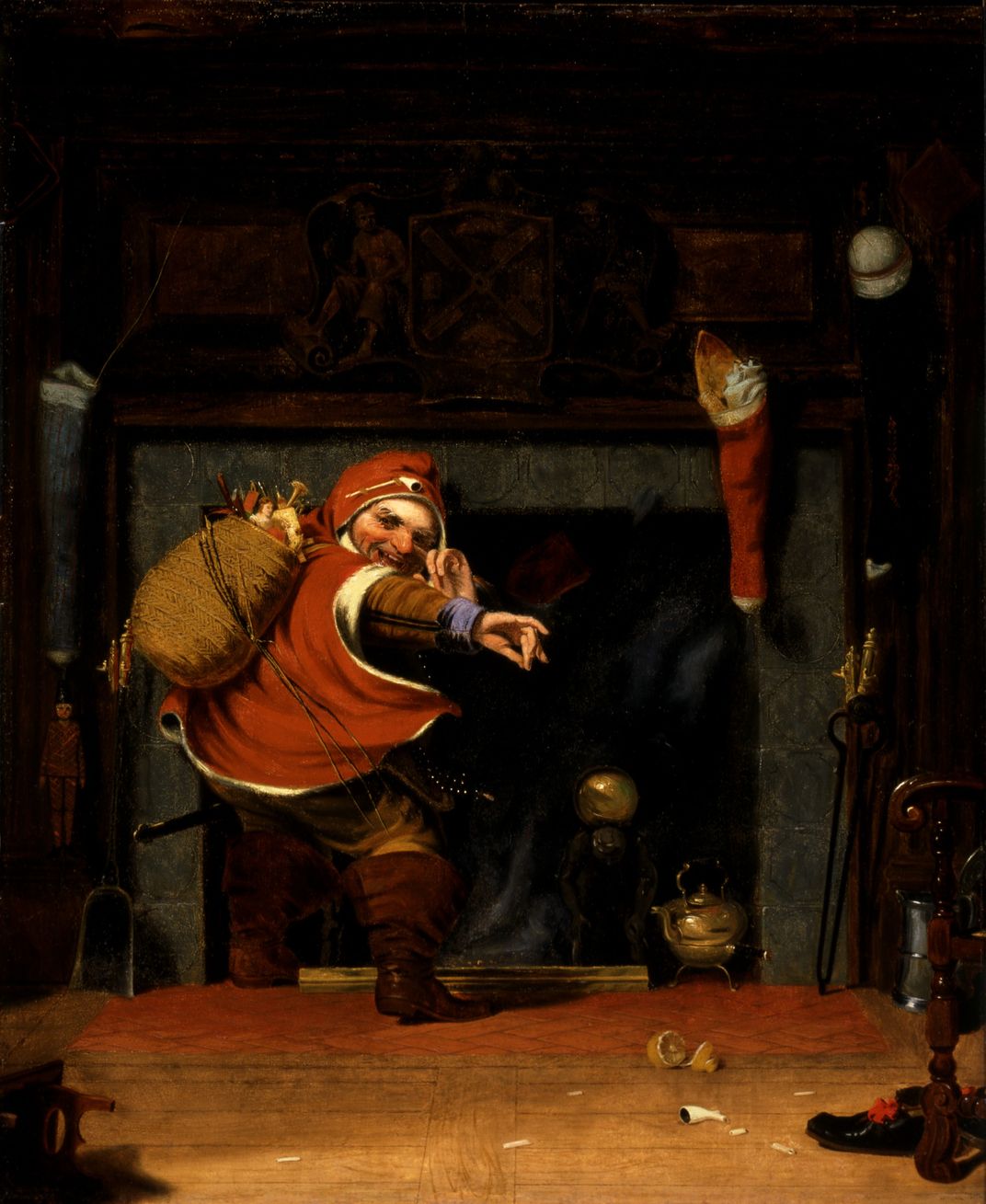A Mischievous St. Nick from the Smithsonian American Art Museum
The 19th-century artist Robert Walter Weir took inspiration from Washington Irving to create a prototype of Santa Claus
/https://tf-cmsv2-smithsonianmag-media.s3.amazonaws.com/filer/b3/14/b314d1dd-981f-4113-b290-42c07c8205d7/saam-197751_1detail.jpg)
It’s a safe bet that the benign, bearded, well-fed fellow who inhabits the imaginations of millions of American children at Christmas bears little resemblance to the mischievous St. Nick depicted in a painting by the 19th-century artist Robert Walter Weir.
Weir’s circa 1838 creation, today residing in the collections of the Smithsonian American Art Museum (SAAM), harks back to a vanished world of New York City aristocrats. The painter was a member of a well-heeled gentlemen’s society, the Knickerbockers, many of whose members traced ancestry directly to Manhattan’s original 17th-century Dutch settlers. St. Nicholas, as it turns out, was a central figure in the popular culture of the Netherlands, beloved as the bearer of gifts in the Christmas season. For the early Dutch colonists in the New World, the saint’s feast day—December 6—was eagerly anticipated. Northern Europeans traditionally put out boots on the eve of the sixth for gifts delivered by the saint. And the children of New Amsterdam did the same.
Weir’s portrayal of St. Nicholas was inspired in part by the descriptions of a fellow Knickerbocker, Washington Irving, the celebrated author of “Rip Van Winkle” and “The Legend of Sleepy Hollow.” Irving’s A History of New York from the Beginning of the World to the End of the Dutch Dynasty, published on St. Nicholas Day, December 6, 1809, was replete with charming digressions. Among them was a set piece on the saint, portraying him as an elfin, antic figure, his appearance drawn from the ranks of the Dutch bourgeoisie. Smoking a clay pipe and “laying his finger beside his nose,” Irving wrote, St. Nicholas soars over trees in a flying wagon “wherein he brings his yearly presents to children.” Irving also advanced the notion that the saint descended into chimneys to bestow his treats.
A few years later, in 1823, another Knickerbocker, Clement C. Moore, offered his own riff on Irving’s version of St. Nicholas. Moore’s instantly popular poem “A Visit from Saint Nicholas” introduced the slightly cloying, but instantly and sensationally popular, symbol of the season—a “chubby and plump...right jolly old elf.” (There are those who contend that an author named Henry Livingston Jr. penned the poem, but that’s another story altogether.)
Art historian Lauretta Dimmick, an independent scholar who specializes in 19th-century America, says Weir’s painting of St. Nick may refer back to Irving. It renders the figure “as a fat little man in the burgher attire reminiscent of Irving’s description, rather than as the tall thin bishop” of legend and lore.
Weir’s Nicholas, with an impish gleam in his eye, resembles a classic trickster as much as a jolly gift-giver. He may be poised to fill stockings with toys and goodies—but he also looks as if he could be making off with the family silver. Perhaps the painter also intended to counter Moore’s syrupy account of St. Nick.

According to Dimmick, many of the objects in the painting, and the pictorial style itself, reflect the Dutch period of New York City’s history, an era that had largely disappeared by 1838. Two clay pipes recall both Irving’s earlier description of St. Nicholas as well as the Dutch penchant for smoking, a convention often seen in old-master paintings. A half-peeled orange lies on the floor—a festive delicacy at the time as well as an allusion to Holland’s royal House of Orange. Dimmick says, “The iconography is...erudite, complex and ambitious, expressing the cultural values and aspirations of the Knickerbocker circle.”
Eleanor Harvey, chief curator at SAAM, recalls first examining Weir’s painting in 2006. “What an unpleasant picture,” she thought. Since then, she says, “I’ve come to like it quite a bit, but I think it has next to nothing to do with Christmas. Instead, it seems to be about loss and change.” In that view, the painting is a last hurrah of sorts for a deposed patron saint of a city that was transforming rapidly. “It’s as if we see St. Nick about to go up the chimney,” Harvey told me, “but maybe he won’t be coming back next year.”
True enough. By the late 1800s, Americans were in thrall to a sentimentalized Santa Claus that was in large part the creation of the illustrator-cartoonist Thomas Nast. His figure took on a life of its own, propelled by promotions for Coca-Cola and Macy’s and other advertisements, plus countless books and films. Gone was Weir’s impudent gnome-like Nick, who gives us a quick glance that now seems to say, “I’m outta here.”
/https://tf-cmsv2-smithsonianmag-media.s3.amazonaws.com/accounts/headshot/Owen-Edwards-240.jpg)
/https://tf-cmsv2-smithsonianmag-media.s3.amazonaws.com/accounts/headshot/Owen-Edwards-240.jpg)